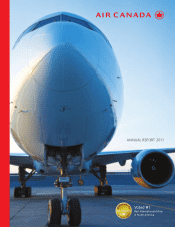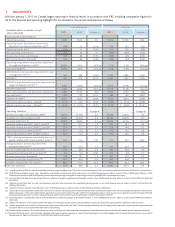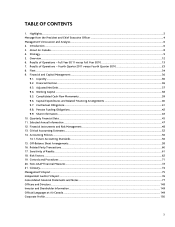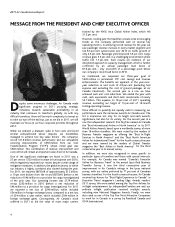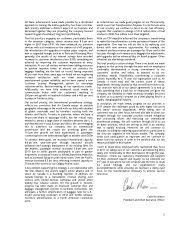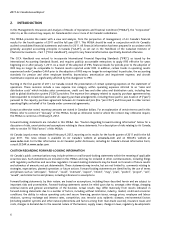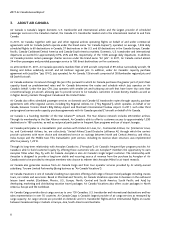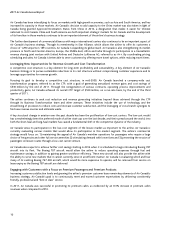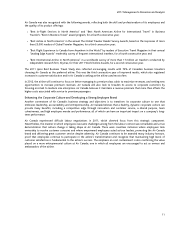Air Canada 2011 Annual Report Download - page 5
Download and view the complete annual report
Please find page 5 of the 2011 Air Canada annual report below. You can navigate through the pages in the report by either clicking on the pages listed below, or by using the keyword search tool below to find specific information within the annual report.
5
All these achievements were made possible by a disciplined
approach to running the airline guided by four basic priorities.
Each priority addresses a distinct aspect of our business and
harnessed together they are propelling the company forward
toward its goal of sustained, long-term profitability.
The first priority is engaging our customers, particularly those
in the premium category, where revenue was 8.3 per cent
higher in 2011 than 2010. We have enhanced our premium
services with such measures as the creation of a VIP program,
the introduction of e-upgrades to replace paper coupons, and
new or upgraded lounges such as in Paris and Winnipeg. More
generally, the results of our internal surveys have recorded
increases in customer satisfaction since 2009, something we
achieved by improving the customer experience at every
interaction. At our call centers we have been adding resources
to quicken response times; at airports our statistics for
baggage handling are the best on record having improved
42 per cent from three years ago; on-board we are registering
increased satisfaction with our meal services and
entertainment system reliability; and we have created a new
Customer Journey Management system to encourage
customer-centric decision-making at our operations center.
Additionally, we have fully embraced social media to
communicate better with our customers, resulting in
200 per cent growth in Facebook followers and a 400 per cent
increase in Twitter activity.
Our second priority, the international powerhouse strategy,
reflects our conviction that Air Canada enjoys an enviable
geographic advantage in the world with our hubs well-situated
at global crossroads used by travellers crossing both the
Atlantic and Pacific. Toronto in particular, where we have a
54 per cent share of passenger traffic, has the critical mass
needed to attract a large share of travellers between the U.S.
and destinations in Asia, Europe and Africa. We are leveraging
this to transform our company into an international
powerhouse and the results are promising given the
110 per cent growth we have experienced in passengers
connecting from one international flight to another since 2009.
To advance these goals, we increased international capacity
6.6 per cent year-over-year through improved aircraft
utilization and strategic deployment of our existing fleet. On
the Atlantic, passenger revenue increased 3.6 per cent over
2010 due to traffic growth attributable in part to greater
frequencies on seasonal routes to Athens, Barcelona, Madrid as
well as increased flying on year round routes. Over the Pacific,
revenue increased 8.3 per cent, reflecting increased capacity to
China and the success of our Calgary-Narita route.
A key element supporting this strategy is our relationship with
the Star Alliance, the world’s largest airline alliance and of
which Air Canada is a founding member. In addition, Air
Canada belongs to a transatlantic revenue sharing joint
venture with United Airlines, Lufthansa and several other
leading Star Alliance carriers. On the ground in Toronto,
progress has been made on improved customer flow and
baggage management systems to facilitate connections. We
anticipate a further simplification of baggage rules for U.S.-
bound connecting customers in 2012 will further enhance
Toronto’s attractiveness as a North American connection
point.
As noted above, we made good progress on our third priority,
which is our Cost Transformation Program. To cite but one area
of cost scrutiny, we continue to focus on our fuel efficiency
program that resulted in savings of 21.6 million kilos of fuel
relative to 2008, five million more than targeted.
With our CTP objective achieved, the company is transitioning
to make this transformation a more permanent feature of the
organization. One way we will do this is by replacing cost
drivers with new revenue opportunities. For example, we
increased ancillary revenue per passenger by 18 per cent in the
last year through such measures as baggage fee adjustments,
paid upgrades and an enhanced Buy on Board program. Other
initiatives are also being considered.
The final priority is culture change. There is no doubt we made
progress on this priority through the year and our employees
continually demonstrated a strong commitment to our
customers’ comfort and safety, as attested to by our
numerous awards. Nonetheless, transforming a corporate
culture, especially at a 75 year old organization such as Air
Canada, is never easy and the current round of labour
negotiations certainly showed us that we still have work to do.
Our objective with all of our labour agreements is to end up
with something that is both fair to employees yet gives the
company the flexibility to make necessary strategic decisions
to allow us to properly compete on a level-playing field in a
rapidly changing global industry.
In conclusion, we made steady progress on our priorities in
2011 despite the challenges posed by both higher fuel prices
and labour contract negotiations. While taking care of
customers was our chief focus, we were also able to direct our
energies through our corporate priorities toward mitigation
and cost-saving efforts and executing our international
powerhouse strategy. We will continue through 2012 to act
on these priorities, which are serving us well in an industry
that is rapidly evolving. Moreover, we will continue to
innovate, including by exploring opportunities to participate in
the low-cost segment of the leisure market. The company
views such participation as important and we continue to
assess low-cost options in order to be satisfied that we can
remain profitable in this market.
I want to thank those employees who maintained their focus
in 2011 on taking care of our customers and delivering them
safely and comfortably to their destinations through the year.
Moreover, I thank our customers, shareholders and suppliers
for their continued support and loyalty. As we celebrate our
75th year of operations we will certainly take the time to recall
our proud heritage and our organization’s many
accomplishments, while ensuring we maintain a steely-eyed
focus on the transformation necessary to achieve success
tomorrow.
Calin Rovinescu
President and Chief Executive Officer

